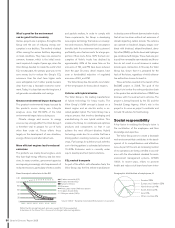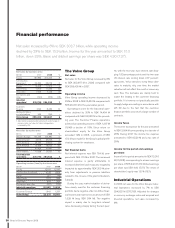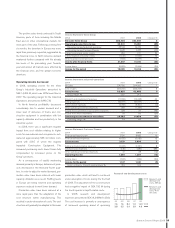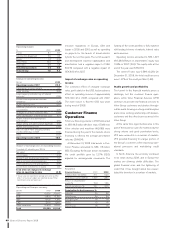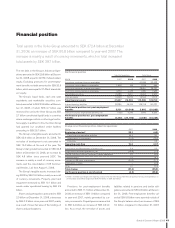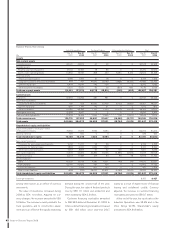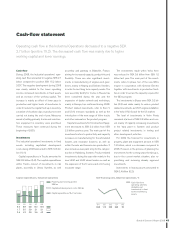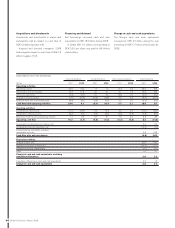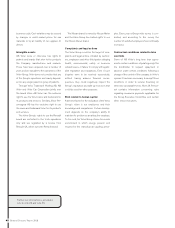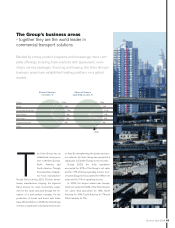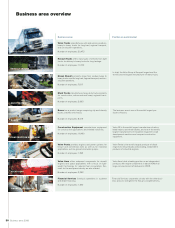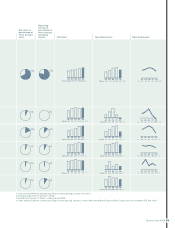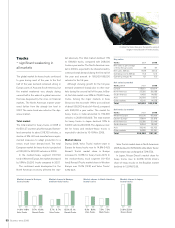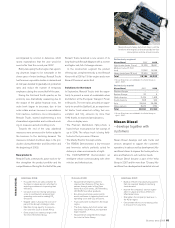Volvo 2008 Annual Report Download - page 49
Download and view the complete annual report
Please find page 49 of the 2008 Volvo annual report below. You can navigate through the pages in the report by either clicking on the pages listed below, or by using the keyword search tool below to find specific information within the annual report.
Risks and uncertainties
All business operations involve risk – managed risk-taking is a condition of
maintaining a sustained favorable profi tability.
Risk may be due to events in the world and can
affect a given industry or market. Risk can be
specifi c to a single company. At Volvo work is
carried out daily to identify, measure and man-
age risk – in some cases the Group can infl u-
ence the likelihood that a risk-related event will
occur. In cases in which such events are
beyond the Group’s control, the Group strives
to minimize the consequences.
External-related risks – such as the
cyclical nature of the commercial vehicles
business, intense competition, changes in
prices for commercial vehicles and govern-
ment regulations;
Financial risks – such as currency fl uc-
tuations, interest levels fl uctuations, valuations
of shares or similar instruments, credit risk and
liquidity risk and;
Operational risks – such as market recep-
tion of new products, reliance on suppliers,
protection and maintenance of intangible
assets, complaints and legal actions by cus-
tomers and other third parties and risk related
to human capital.
In 2008 a new Group-wide risk manage-
ment model based on the Enterprise Risk
Management concept was introduced.
Short-term risk factors
The fi nancial turmoil and credit tightening has
led to an extreme cautiousness among cus-
tomers when it comes to deciding on invest-
ments, which in turn may cause a decrease in
demand for Volvo products.
The development of the fi nancial markets
during the second half of the year has led to an
intensifi cation of Volvo’s work with fi nancial
risks. The credit risks are continuously man-
aged through active credit monitoring and
there are regular controls that provisions are
made on incurred losses for doubtful receiv-
ables in accordance with applicable account-
ing principles.
The present market conditions also limit the
accessibility to credits and loan fi nancing,
which may negatively affect customers, sup-
pliers, dealers as well as the Volvo Group. Sup-
pliers’ fi nancial instability could result in deliv-
ery disturbances. A sound balance between
short- and long-term borrowing, as well as bor-
rowing preparedness in the form of overdraft
facilities, is intended to meet the long-term
fi nancing needs of the Volvo Group.
In the course of its operations, Volvo is
exposed to residual value risks through oper-
ating lease agreements and sales combined
with repurchase agreements. The estimated
net realizable value of the products is continu-
ously monitored on an individual basis. A
decline in prices for used trucks and equip-
ment may negatively affect the consolidated
operating income.
High inventories in the truck industry and the
construction equipment industry and low demand
may have a negative impact on the prices of used
trucks and construction equipment.
The reported amounts for contingent liabili-
ties refl ect Volvo’s risk exposure. Total contin-
gent liabilities at December 31, 2008,
amounted to SEK 9.4 billion, an increase of
SEK 1.2 billion compared to December 31,
2007. Included in the total is a contingent lia-
bility of SEK 0.6 billion pertaining to a claim on
Volvo Powertrain to pay penalties following a
Heavy truck registrations, > 16 tons Emissions regulations for trucks and buses
Europe
North America
Vehicles, thousands
0807060504
319329295277255
185
208349308249
35
43484842
Japan
US 10, 2010
US 07, 2007
0,16
0,14
0,12
0,10
0,08
0,06
0,04
0,02
0,00
Particles, g/kWh
NOx, g/kWh
012345678
Euro II, 1996
Euro III, 2002
Euro IV, 2006
Euro V, 2009
US 02, 2002 The currently applicable emissions standards are Euro IV
in Europe and US 07 in North America. The difference
between Euro III and Euro IV is considerable. Emissions of
particles have been reduced by 80%, and of NOx, by 30%.
During 2009, emission regulations will be lowered further
with the Euro V implementation. Euro V will entail a 50%
reduction of NOx emissions compared to Euro IV.
1) NOx value measured according to ECT.
Euro VI, 20131)
45
Board of Directors’ Report 2008



